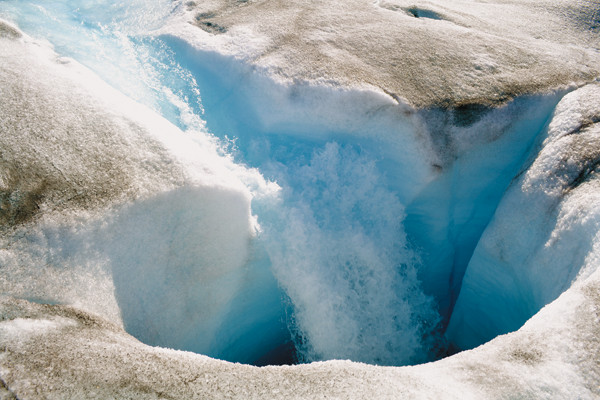
by Timothy Oleson Monday, January 5, 2015

Surface meltwater from the Greenland Ice Sheet pours into a moulin, emptying into a network of drainage channels at the base of the glacier. Credit: Lauren Andrews.
From Antarctica to the Arctic; from polar caps, permafrost and glaciers to ocean-rafted sea ice; and from burly bears to cold-loving microbes, fascinating science is found in every nook and crevasse of Earth’s cryosphere, and new findings are announced often. Here are a few of the latest updates.
Water that collects at the base of glaciers during the warm melt season lubricates movement of the ice over the ground beneath. But many aspects of this process — including how meltwater modulates glacial velocities on daily and seasonal timescales — remain unclear. In a new study in Nature, Lauren Andrews of the University of Texas at Austin and colleagues have helped illuminate the effects of subglacial hydrology on ice velocities in the Paakitsoq region of western Greenland.
The team measured water pressures in large naturally occurring cavities called moulins — which funnel meltwater from a glacier’s surface to networks of drainage channels at its base — as well as in boreholes drilled through the ice into areas of the base not directly connected to the drainage channels. They then compared the pressures with GPS measurements of ice velocity. The team found that pressure changes in the moulins, which correspond to increases or decreases in meltwater flow through the drainage channels, correlated with daily changes in ice velocity. A previously observed but unexplained longer-term slowdown of glacial velocities late in the melt season correlated, on the other hand, with pressure drops in the areas unconnected to the channels. The findings show that changing meltwater drainage both from the “unchannelized” portions of the glacier as well as from the channels impacts ice movement, the researchers wrote, and that a more nuanced picture of glacial undersides is necessary to understand their behavior.
The likelihood of severe winters in central Eurasia, including parts of China, Kazakhstan, Mongolia and Russia, is roughly twice what it was several decades ago, according to a new study in Nature Geoscience. Masato Mori of the University of Tokyo in Japan and colleagues simulated atmospheric conditions over Europe and Asia, considering variable levels of sea ice in the Barents and Kara seas. They found that as sea-ice levels declined, the region was more prone to so-called “blocking” wind patterns that pulled cold Arctic air farther south than normal for extended periods. The new modeling supports earlier observational studies that have correlated recent cold winters in Eurasia with dwindling sea ice. However, the researchers reported, as sea-ice levels continue to drop, the increased odds of harsh winters may abate toward the end of this century.
Figuring out why the glaciers of the Karakoram Mountains — which range over portions of western China, northern India and northern Pakistan — appear to be holding steady or perhaps even growing in size while most of the world’s mountain glaciers are shrinking has been difficult, given the region’s remote, rugged terrain. Now, scientists using a high-resolution climate model along with meteorological observations to investigate the Karakorams, as well as areas of the nearby Himalayas and Tibetan Plateau where glaciers are losing mass, may have figured out why. In Nature Geoscience, Sarah Kapnick of Princeton University and colleagues reported that whereas the Himalayas receive most of their annual precipitation as rain during the summer monsoon season, the Karakoram region receives the majority of its precipitation in the winter, meaning it falls as snow and feeds the glaciers there. This meteorological distinction “uniquely protects [the Karakorams] from reductions in annual snowfall under climate warming,” the researchers wrote.
© 2008-2021. All rights reserved. Any copying, redistribution or retransmission of any of the contents of this service without the expressed written permission of the American Geosciences Institute is expressly prohibited. Click here for all copyright requests.